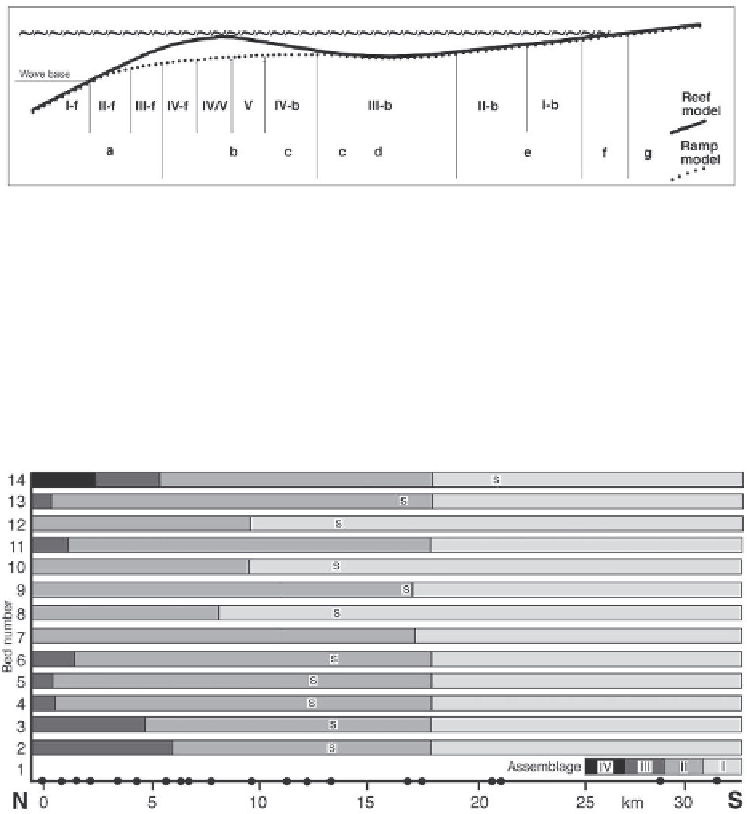Geology Reference
In-Depth Information
Fig. 14.11.
Integrated reef/ramp model for Devonian carbonates
(modified from Machel and Hunter 1994). The reef model
explained in Fig. 14.9 (facies zones indicated by Roman numbers) and the ramp model (facies indicated by small letters) are
complementary. They overlap in space and partially substitute for one another. An integration of the models shows the facies
distribution from the supratidal zones across a hypothetical carbonate shelf to the basin. The main differences occur in the
outer shelf region where reefs develop in the case of a distinct shelf break. In the case of a gently sloping ramp, the litho/
biofacies a and b will develop. Patch reefs (c) are most likely to form within facies b and d.
a - Burrowed argillaceous mudstones and wackestones; fossils rare; scattered brachiopods and crinoids. b - Mudstone with
carbonate nodules in shaly matrix. c - Patch reefs exhibiting stromatoporoid-coral floatstones to rudstones with bulbous and
tabular stromatoporoids; and a wackestone-packstone matrix. d -
Amphipora
floatstones and grainstones. e - Vuggy, poorly
fossiliferous mudstones. f - Laminated and fenestral dolomite. g - Mudstone breccia, clasts correspond to reworked facies f.
Fig. 14.12.
Differentiation and sequence stratigraphic interpretation of an outer homoclinal carbonate ramp based on
microfossil assemblages.
The figure displays the biotic gradients of Early Mississippian ramp carbonates in the Sacramento
Mountains of south-central New Mexico (Jeffery and Stanton 1996). Black dots on the horizontal line show the position of
measured and sampled stratigraphic sections. The length of the bars indicates the lateral extent of fossil assemblages. The
letter S indicates the southernmost occurrence of sponge spicules generally regarded as an indication of relative deep-water
environments.
The gently dipping thin- to medium bedded carbonates (mostly bioclastic wackestones) of the Alamogordo Member can
be laterally traced bed-per-bed for more than 30 km. The thickness of the member is 1.5 m in the North and 10.5 m in the
South. The sediment is interpreted as an autochthonous deposition because of the lack of structures indicative of transport,
the presence of well preserved non-abraded fossils, patchy distributions of rock types in contrast to down-ramp gradients of
depth-sensitive assemblages, common occurrence of fossils in life position, geopetals in undisturbed position, and beds
traceable into and through mud mounds formed on the deeper ramp. The biotic components (hexactinellid sponge spicules,
crinoid and other echinoderm debris, fenestellid bryozoan hash, and ostracods) are used to define assemblages that vary in
relation to their shoreward and basinward ramp position. Assemblage I of the deepest water consists of crinoid/echinoderm
debris, fenestellid hash and ostracods. Assemblage II contains the biota of assemblage II plus stacheiins (possible algae), rare
salebrids (possible bryozoans) and commonly abundant sponge spicules. Assemblage III is characterized by members of
assemblage II plus plurilocular foraminifera. The shallowest assemblage IV consists of assemblage III plus green algae.
Within any bed, assemblage I is farthest down-ramp (south) and assemblages III or IV are the farthest up-ramp (north).
The positions of the assemblages on the ramp shift laterally in successive beds of the stratigraphic sections, indicating
variations in sea level and water depth. The beds 1-6 contain the deepest and deep assemblages I, II and III; in the middle
beds 7, 8, 9, 10 and 12 the assemblages shift up-ramp (from right to left of the figure), with the greatest shifts in bed 8. This
bed represents the maximum flooding interval within the aggradational sediments of the Alamogordo Member. In beds 11, 13
and 14 the assemblages shift back down-ramp, leaving space for the shallowest assemblage IV in the north. The beds below
bed 8 represent a part of the transgressive system tract, the beds above bed 8 document the initial highstand tract. Modified
from Jeffery and Stanton (1996).

